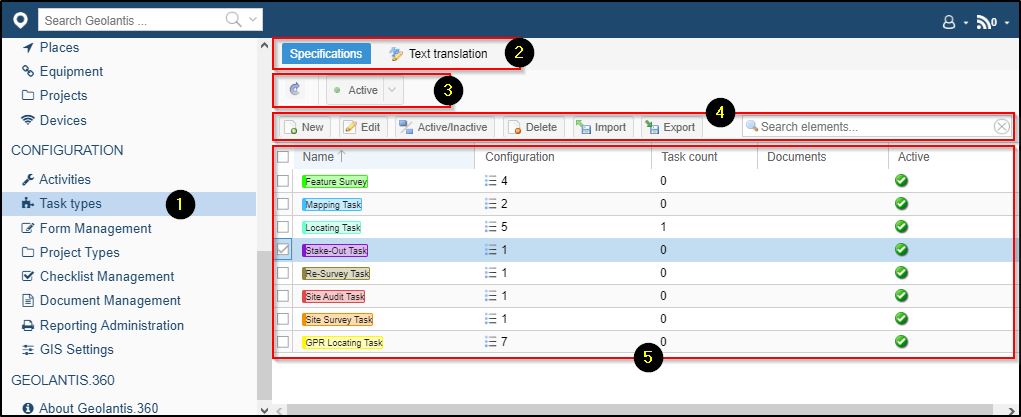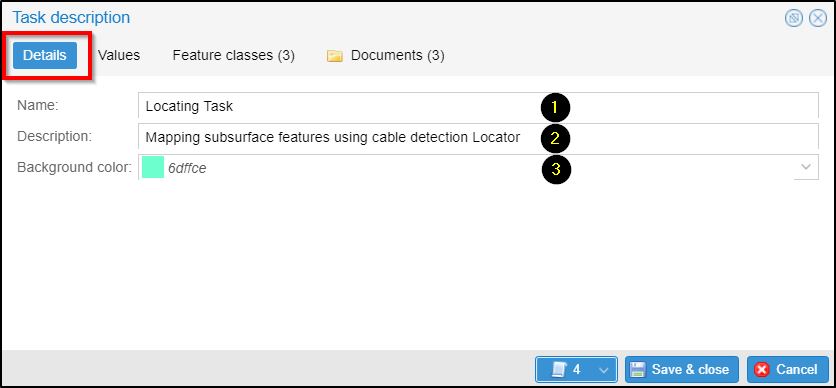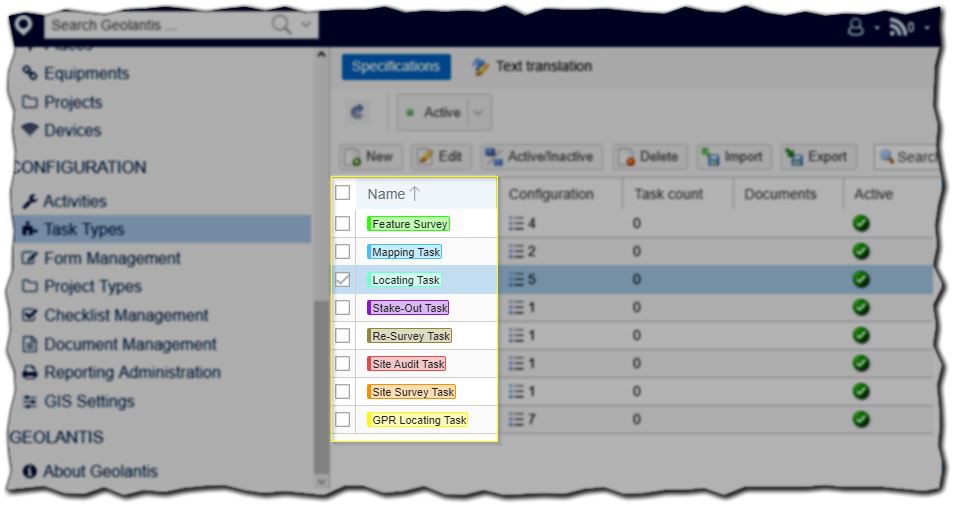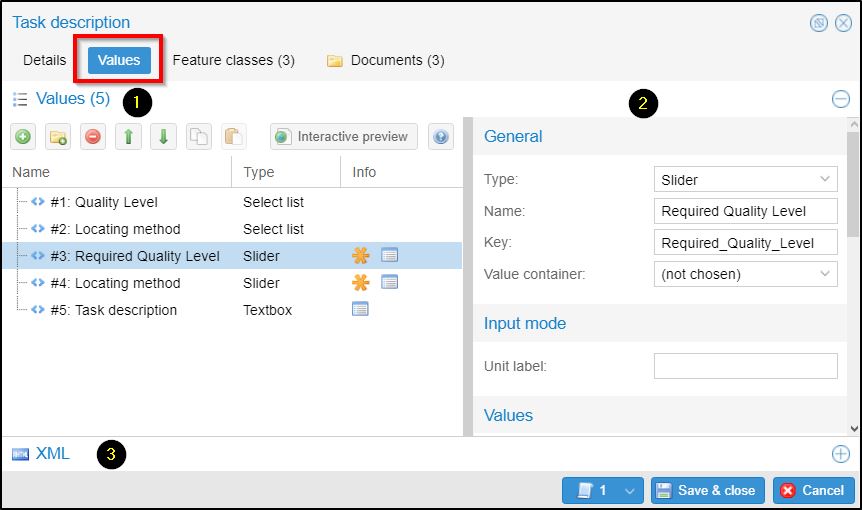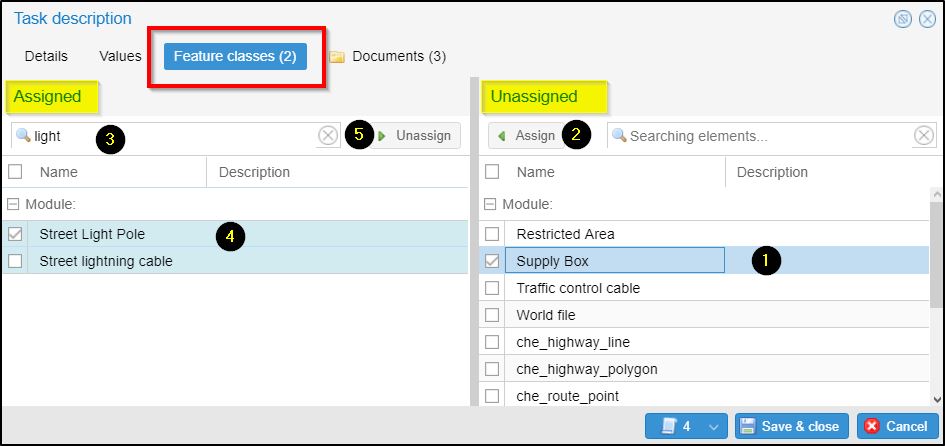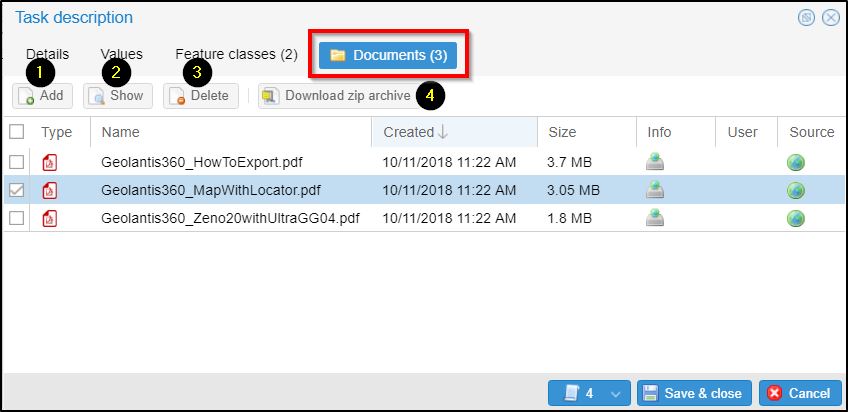Task Types Overview
Task Types define the potential categorization of field tasks in regards to the project needs, which enables field users to store specific information about a field task. Task Type information (attributes) are different from one Task Type to another.
Geolantis.360 offers a set of standard Task Types templates, moreover, authorized Geolantis.360 users or project managers can create new customized Task Types.
Managing Task Types
Use any of the existing Task Types templates, or create a new custom Task Types. Each Task Type can have specific attributes which define the required information to be stored while completing a task of the associated Task Type. See the description below to manage Task Types:
1. Go to the Task Types page under the Configuration section;
2. Switch between the Specification tab and the Text Translation tab;
3. Use the filter bar to list active, inactive, or all Task Type entries;
4. Create and edit Task Type entries using the controls below:
| Option | Symbol | Description |
| New | Create a new customized Task Type | |
| Edit | Modify an existing Task Type | |
| Active/Inactive | Set a selected Task Type as Active or Inactive | |
| Delete | Remove an existing Task Type | |
| Import | Import single or multiple Task Types from an external XML file that has been exported previously from Geolantis.360 | |
| Export | Export a single or multiple selected Task Types to an XML file as a backup that can be re-imported into Geolantis.360 | |
| Search | Use the search bar to find a specific Task Type by name. The search results will appear only after typing at least three characters |
5. The Task Types list includes the following information (columns):
| Name | The given Task Type name | |
| Configuration | Indicates the number of attributes (value) associated to each Task Type | |
| Task Count | Indicates the number of saved task instances of each Task Type | |
| Documents | Shows the number of attached documents to each Task Type. Attached documents can be instruction files or reference photos provided to the field operators | |
| Active | Shows the task status (active/inactive) according to the applied status filter as described above in item list number (3) | |
Task Type Setup
Select any of the existing Task Type templates and click on Edit, or click on New. In the Task Description window, configure a Task Type as follows:
Details Tab
| 1 | Name | Provide a reasonable name for the Task Type. |
| 2 | Description | Provide a brief description and instructions about the purpose of the Task Type. |
| 3 | Background color | Define the color of the Task Type. The color applies to the ‘Name’ column in the Task Types list.
|
Values Tab
- Use the attribute editor to associate attribute fields to the dispatched tasks of a particular Task Type.
- Configure the parameters of each attribute type (general parameters, input mode, visibility options, expert settings,…, etc).
- Use the XML editor for advanced attributes configuration.
Feature Classes Tab
Linking feature classes to a Task Type restricts the field user to only survey those feature classes while they are undertaking the task.
The number between brackets indicates how many feature classes are assigned to the associated Task Type. Find the assigned feature classes on the left-hand side, and the unassigned feature classes on the right-hand side.
In the feature classes tab, assign or un-assign feature classes to the associated Task Type as follows:
- Select one of the un-assigned feature classes on the right-hand side;
- Click on the Assign button to move the selected feature classes to the left-hand side, where the assigned feature classes to the associated Task Type are listed;
- To move feature classes back from the assigned side to the unassigned side, it is possible to use the search bar to find a specific feature class by name directly;
- Select an assigned feature class;
- Click on the Unassign button to move the feature class to the un-assigned side.
Documents Tab
In the Documents tab, instruction files or reference photos can be attached so that field operators can access them while completing a task of the associated Task Type.
If a document is submitted by the field operator during a task completion; managers on Geolantis.360 web portal can also access and download the Task Type attachments.
The number between brackets indicates how many documents are attached to tasks of the associated Task Type.
- Add new documents to the associated Task Type.
- Show submitted document(s) by field operators during the completion of a task of the associated Task Type.
- Delete selected document(s).
- Download multiple selected documents in a zipped folder.
